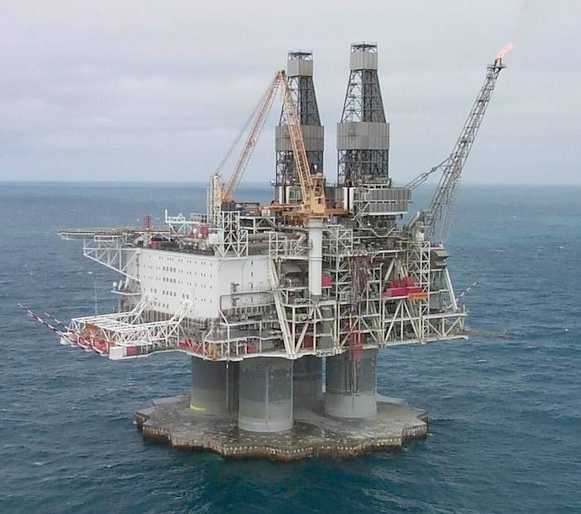This is the 2nd of 4 articles on current energy producing projects recently published in the Natural Resources Magazine supplement to Atlantic Business Magazine.
To follow are my articles on energy projects to come, the Atlantic energy superstore, energy transportation, energy-related work outsourced into this region and finally energy-related opportunities for local companies at locations overseas.
------------------------------
The Hibernia oil development is the most ambitious of the projects off Canada’s East coast. The 5th largest field ever discovered in Canada, it lies in the North Atlantic, approximately 315 kilometres southeast of St. John's, Newfoundland.
The field was discovered in 1979, but the project was mired in federal-provincial jurisdictional warfare until the Atlantic Accord was signed in 1985 and in commercial negotiations until the early 1990s. Acknowledged as one of the engineering marvels of the modern world, the production platform was towed out to the Hibernia field, grouted to the ocean floor in June and began producing oil on November 17, 1997.
 The Hibernia platform is 224 metres in height and comprises processing, power generation and accommodations modules set atop a half million tonne concrete gravity based structure (GBS). The GBS is embedded two meters into the sea floor in some 80 metres of water and boasts a unique serrated outer wall designed to resist impact by a six million tonne iceberg. Heavy but hollow, the GBS contains storage cells for produced oil as well as magnetite ballast. The entire structure weighs 1.2 million tons; it is the largest oil platform in the world.
The Hibernia platform is 224 metres in height and comprises processing, power generation and accommodations modules set atop a half million tonne concrete gravity based structure (GBS). The GBS is embedded two meters into the sea floor in some 80 metres of water and boasts a unique serrated outer wall designed to resist impact by a six million tonne iceberg. Heavy but hollow, the GBS contains storage cells for produced oil as well as magnetite ballast. The entire structure weighs 1.2 million tons; it is the largest oil platform in the world.
Oil production ranges up to 220k barrels per day. The GBS’s tank cells can store 1.3 million barrels of oil before offloading for transportation to either by shuttle tanker to the trans-shipment facility at Whiffen Head onshore Newfoundland or by conventional tanker directly to markets in the East coast of Canada and the US.
Hibernia produces light sweet crude, with a density of about 32 to 34 API and a sulphur content, by weight, of 0.4 0.6%. The latest estimates point to oil reserves of 1.244 billion barrels, with 3 billion barrels of oil in place.
To follow are my articles on energy projects to come, the Atlantic energy superstore, energy transportation, energy-related work outsourced into this region and finally energy-related opportunities for local companies at locations overseas.
------------------------------
The Hibernia oil development is the most ambitious of the projects off Canada’s East coast. The 5th largest field ever discovered in Canada, it lies in the North Atlantic, approximately 315 kilometres southeast of St. John's, Newfoundland.
The field was discovered in 1979, but the project was mired in federal-provincial jurisdictional warfare until the Atlantic Accord was signed in 1985 and in commercial negotiations until the early 1990s. Acknowledged as one of the engineering marvels of the modern world, the production platform was towed out to the Hibernia field, grouted to the ocean floor in June and began producing oil on November 17, 1997.
 The Hibernia platform is 224 metres in height and comprises processing, power generation and accommodations modules set atop a half million tonne concrete gravity based structure (GBS). The GBS is embedded two meters into the sea floor in some 80 metres of water and boasts a unique serrated outer wall designed to resist impact by a six million tonne iceberg. Heavy but hollow, the GBS contains storage cells for produced oil as well as magnetite ballast. The entire structure weighs 1.2 million tons; it is the largest oil platform in the world.
The Hibernia platform is 224 metres in height and comprises processing, power generation and accommodations modules set atop a half million tonne concrete gravity based structure (GBS). The GBS is embedded two meters into the sea floor in some 80 metres of water and boasts a unique serrated outer wall designed to resist impact by a six million tonne iceberg. Heavy but hollow, the GBS contains storage cells for produced oil as well as magnetite ballast. The entire structure weighs 1.2 million tons; it is the largest oil platform in the world.Oil production ranges up to 220k barrels per day. The GBS’s tank cells can store 1.3 million barrels of oil before offloading for transportation to either by shuttle tanker to the trans-shipment facility at Whiffen Head onshore Newfoundland or by conventional tanker directly to markets in the East coast of Canada and the US.
Hibernia produces light sweet crude, with a density of about 32 to 34 API and a sulphur content, by weight, of 0.4 0.6%. The latest estimates point to oil reserves of 1.244 billion barrels, with 3 billion barrels of oil in place.










3 comments:
Have there been any iceberg impacts on the Hibernia GBS and if there have been, how has the structure been affected ?
Good question.
My understanding is that there have never been a significant impact partially because big icebergs are towed out of the way and partially because the original iceberg threat was overstated.
So it turns out that Hibernia is grossly over engineered for iceberg impacts; icebergs are smaller and fewer than anticipated. That's why the Hebron GBS is 1/3 smaller.
Post a Comment